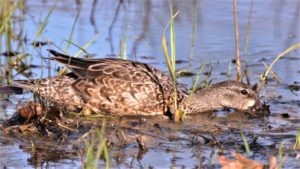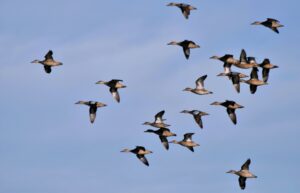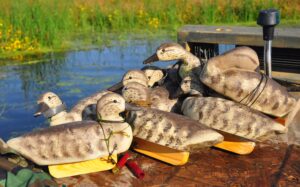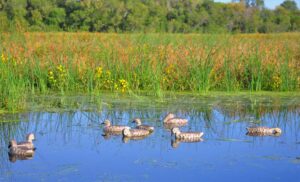Photography courtesy of Lowell Washburn, all rights reserved.
With sixteen full, sunrise to sunset days of high-quality recreational opportunities, Iowa’s special teal seasons are the best single change in waterfowl regulations in the past fifty years. Tall statement, I know. But there’s a lot to like about the Iowa teal season. The weather is mild, the birds abundant. Always on the lookout for a free meal, migrating teal utilize a wide variety of wetland habitats ranging from our largest public marshlands to the tiniest Back-Forty pothole. There are lots of ducks, and lots of people, in lots of places. Plenty of room for hunters to spread out.

You don’t need a truckload of expensive equipment to enjoy a successful teal hunt; waterproof boots and a light bag of decoys will do the job. Since blue-winged teal lack the wariness exhibited by most web-footed species, hunter success – regardless of a person’s age or level of expertise — generally runs high. Best of all, the teal season is a “free gift” of sorts, providing bonus hunting days that do not subtract from days allotted for regular duck seasons. For Iowa outdoor enthusiasts, teal seasons are clearly a win win.
In the eight years since Iowa teal seasons have been reinstated, each season has provided at least one memorable feature – something that set it apart from all previous hunts. Preseason habitat conditions, for example, were a major concern this year. With only days remaining until the September 1st opener, most wetlands were reduced to puddle dotted mudflats. Some were completely dry. But habitats improved dramatically when, at the eleventh hour, two back-to-back weather events dropped a combined total of anywhere from 9 to 11 inches of heavy rainfall across the most severely parched regions of the state. Wetlands quickly filled to capacity, some rose beyond crest. By the time the big day arrived, sufficient numbers of new migrants had arrived on revived marshlands that most — if not all — hunters were successful in finding and taking home some teal. Some parties encountered exceptional numbers of blue-wings, enabling them to attain their combined, six-duck limits with minutes of the sunrise opener.

My season began on an isolated wetland that, like many others, had recently been bone dry. But due to recent rainfall, the pothole was now covered with a foot of fresh crystal-clear water. The wetland also harbored an abundant crop of arrowhead, bidens, smartweed and other duck-preferred food items. The regenerated wetland would provide a welcome refueling station for flocks of southbound blue-wings – or so I hoped.
Because teal decoys are small and lightweight, I can generally carry around 30 into marshes I hunt on foot. But this year, I had a last-minute change of plans. When not serving as an Iowa Conservation Officer, my son Matt, also enjoys carving working decoys – mainly redheads, ‘cans, and mallards. This year, he wanted to add a set of blue-winged teal to the lineup but ran out of time before completing the rig. Nevertheless, he managed to finish a group of eight teal before the season began. Since Matt would be working on the duck opener, he offered to let me ‘test drive’ the new decoys. To give them the fairest evaluation, I decided to leave my factory produced decoys at home which reduced my spread from 30 decoys to just eight.
The big day finally arrived. I still get excited over the prospects of the duck opener and was at the marsh by midnight. After setting my eight decoys, there was little to do but dream of ducks. My anticipation further intensified as the first hint of daylight eventually appeared in the east. As the light slowly increased, Matt’s cedar effigies began to look more and more like real ducks. No two decoys were alike. Some simply swam about while others appeared to dabble at the surface. With eyes closed and bill tucked into its back, one blue-wing was taking a nap. If the decoys looked half as good to the teal as they did to me, we would soon be in business.
Appearing as dim shadows, the ducks were beginning to fly. And although the wait seemed endless, legal shooting time finally arrived. At that very second, a pair of blue-winged teal came scorching past. Upon spotting the decoys, the pair immediately hit the brakes, turned, and came directly to the eight wooden counterfeits. Shouldering my Ruger .28 gauge, I managed to collect both birds. For me and the new decoys, it was a great start to a new season. The celebration was short lived, however. When the next flock came roaring in, I rose, picked a bird, and then cleanly missed — with both barrels.
And so, it went – hits and misses, good shots and bad. The misses didn’t matter. The teal were flying. The decoys were working, and the blue-wings were as fat as they were beautiful. For me, fall had officially begun. Best of all, I still had an additional fifteen bonus days to enjoy the marsh before the “Real Duck Seasons” began. Iowa’s special teal seasons are the single best change in waterfowl regs in last fifty years.



 Tom Cope
Tom Cope Sue Wilkinson
Sue Wilkinson Susan Judkins Josten
Susan Judkins Josten Rudi Roeslein
Rudi Roeslein Elyssa McFarland
Elyssa McFarland Mark Langgin
Mark Langgin Adam Janke
Adam Janke Joe Henry
Joe Henry Kristin Ashenbrenner
Kristin Ashenbrenner Joe Wilkinson
Joe Wilkinson Dr. Tammy Mildenstein
Dr. Tammy Mildenstein Sean McMahon
Sean McMahon